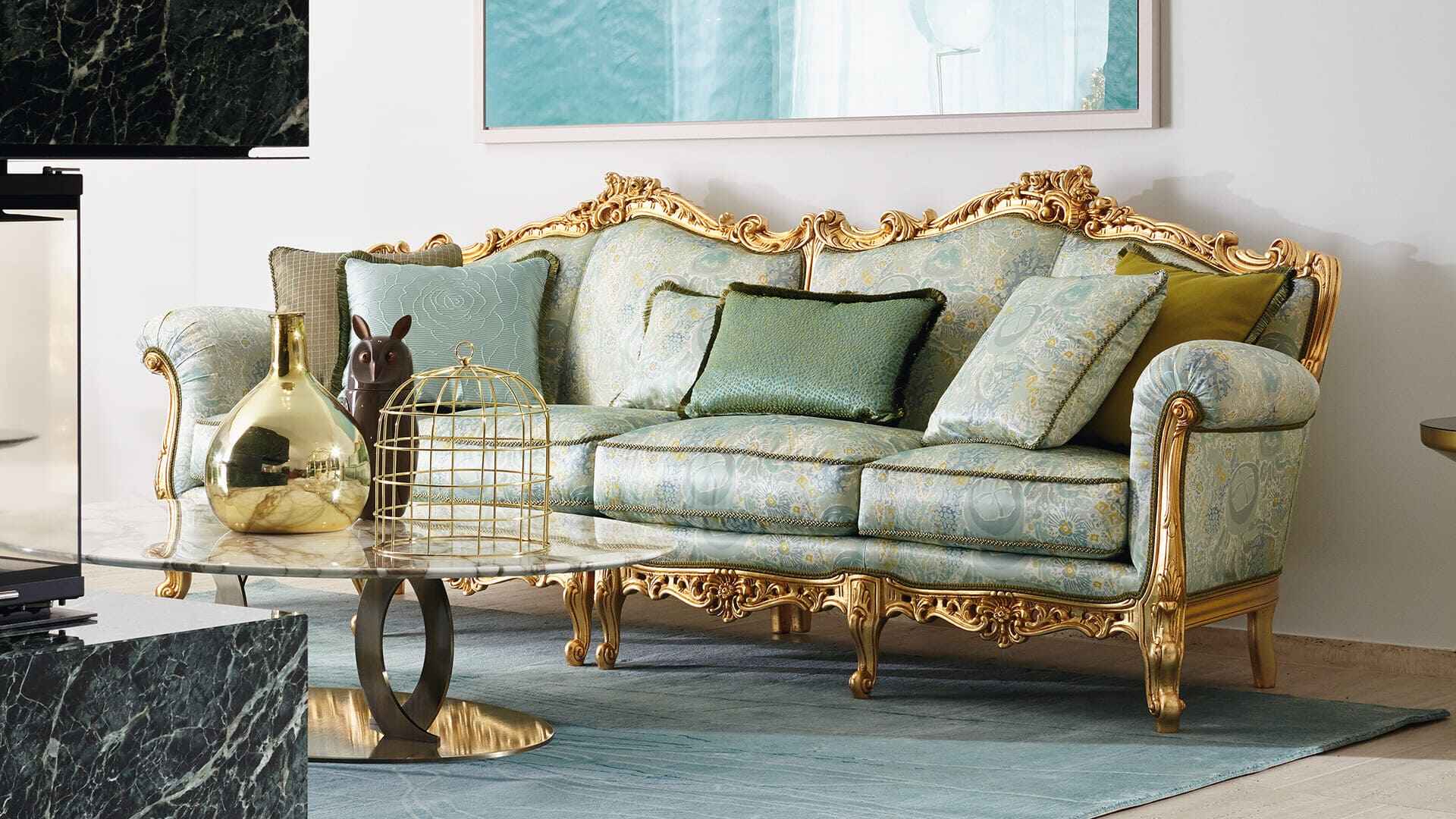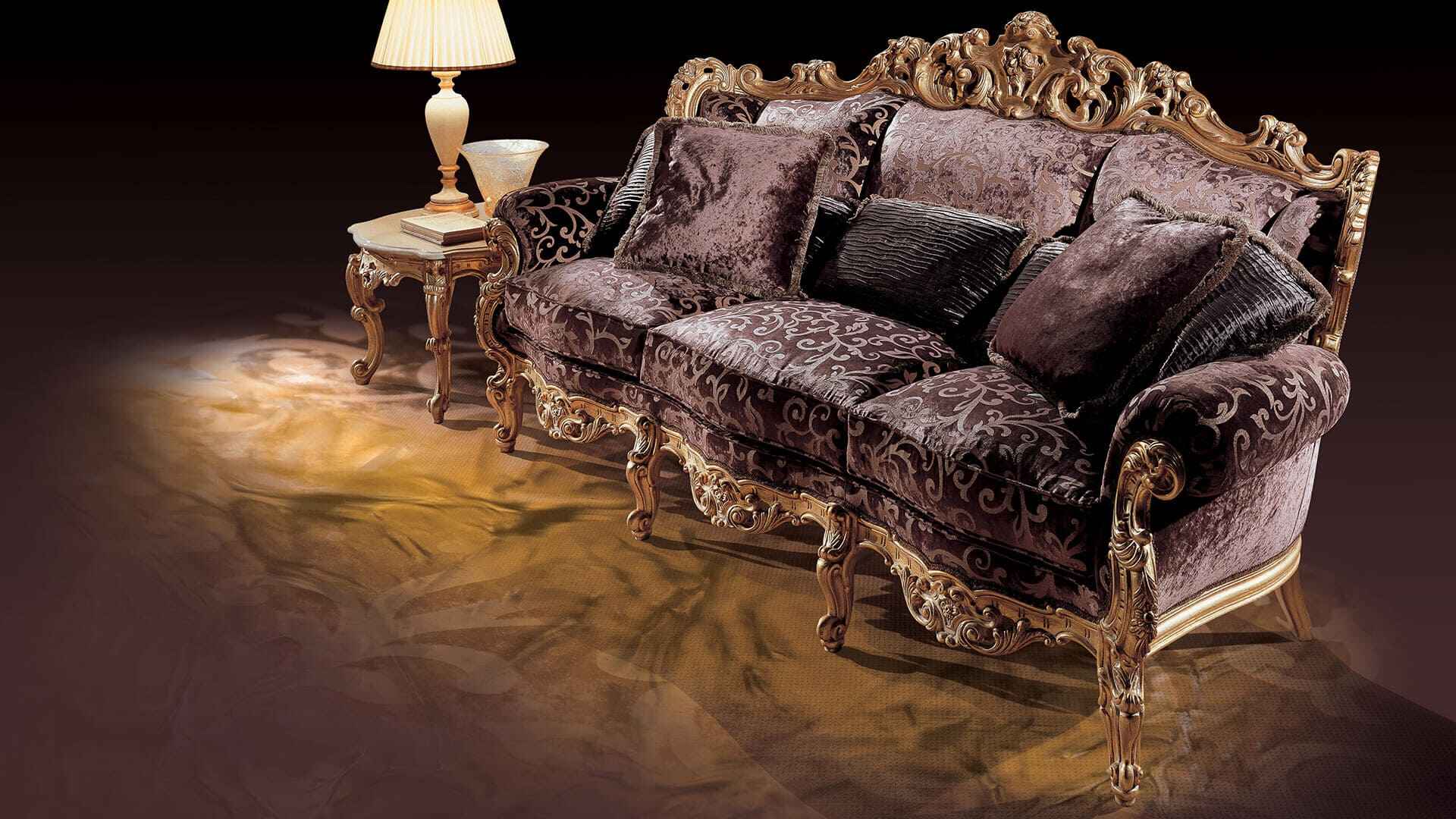
21 Oct How to choose baroque-style furniture for your living area
A detail of the Baroque sofa from the interior Casino Royale, a collection with a multifaceted soul that reinterprets the classic features of its furniture in a contemporary way. The result is sinuous silhouettes with memorable details such as precious finishes and bold textile combinations.
How to choose baroque-style furniture for your living area
Baroque-style furniture is among those categories of “classic” interior design that still continue to exercise extraordinary appeal to a wide audience of designers and end users, so much so that it is defined as a refined choice for countless contemporary interior design projects. The sumptuous of the upholstery and textile furnishings, the fine wood veneers – from dark ebony to fir, walnut, and oak-elaborately decorated and the extraordinary synergy between materials, shapes and overall atmosphere translate into setting of extraordinary beauty, which also find their place in the houses we currently live in.
At the heart of these environments is, of course, the living area-that is, the space in the home designed to be the focus of convivial, relaxing and sharing moments. It is in this microcosm that guests are greeted, drinks are sipped, and people relax while conversing or engaging in recreational activities, and it is easy to see why its interior design is so important. The design of the living room will necessarily have to take into account the practical uses of this domestic space as much as its scenic impact, which will in fact form the atmosphere in which guests and inhabitants will immerse themselves, breathe and be inspired by.
Choose Baroque-style furniture for the living area is therefore a project that must consider multiple factors to be fully satisfying: the functions to be fulfilled by the environment, the type of furniture elements and accessories to be placed within it, the colors, combinations, materials and peculiarities of each piece.
To navigate this maze of variables, therefore, it is first important to understand what baroque-style furniture is and what unique features it should have in the interior design of a current living room.
Baroque-style furniture: what to know for an effective interior design project
The origin of the cultural movement-and thus of the Baroque style-is all-Italian and, in fact, the term refers not only to furniture, but also to the philosophy, music, literature, and art that characterized the period between the 17th and the first decades of the 18th century.
The word “baroque,” in itself, is therefore intrinsically connected to the very concept of taste typical of all artistic manifestations of the period, especially when connoted by flair, imagination and creativity. At the same time, Baroque art always displays a solid classicist subtext, still considered the reference language of the time.
Clarifying the origin of the Baroque current and the stylistic thread that runs through all its artistic manifestations is a fundamental premise because, when declined in furniture, this style is strongly inspired by the typical stylistic features of European architecture that emerged in the same period: that of absolutism.
Exactly with stylish furniture, Baroque architecture is also distinguished by an abundance of curved and sinuous lines, with continuous and almost hypnotic movement: great space is given to spirals (simple or twisted, i.e., double) to curves, ellipses, to the point of creating highly polycentric decorations interwoven with one another.
Minimalism, in this current of interior design, does not exist: instead, it is whimsy that is central, and it is reflected both in the refined shaping-in full contrast to the monumental and rigorous appearance of each piece of furniture-but also in the careful wax polishes, the predilection for darker wood tones, and the skillful play of light and shadow that uses the very surface of the furniture as a stage.
Imposing and richly detailed, Baroque-style furniture is thus visually complex, with decorations that are not only imaginative but, in some cases, even bold-though always carefully calibrated. The aesthetic impact is one of absolute richness and opulence, embellished by the presence of fine materials such as silks, marbles, metals, ivory, as well as glass and mirrors, and the skillful use of gilding.
In terms of fabrics and colors, Baroque furniture favors tapestries with plant and figurative motifs, as well as landscape details enhanced by smooth velvets that recall natural hues such as light blue, red, yellow, and dark green.
Finally, the rooms are completed with heavy silk drapes and curtains.
Baroque style in the living area: here are the proposals of Angelo Cappellini
A good baroque interior design project should always involve the judicious placement of certain furniture elements-which, as we have seen, are by their very nature of majestic aesthetics-in the context of a homogeneous background that will come to represent, metaphorically speaking, the painter’s canvas.
In synthesis, Baroque-style furniture should never dominate (or worse yet visually oppress) rooms, but rather enhance and embellish them with their presence, making the overall scenery unique and original. The background in which to place the elements should therefore be soft, understated, and predominantly monochromatic so as to bring out the sumptuous details of each piece and maximize their aesthetic appeal without slipping into kitsch.
When it comes to the baroque interior design of the living area of a current apartment, the “center of the world” will be the sofa: the prince of the living room, the furniture element at the heart of a lively, flashy but not excessive narrative.
When further enriched with a coffee table, armchairs, benches or a framed mirror, a Baroque-style living room will never be too gaudy: on the contrary, it will look magnificent.

One example is Angelo Cappellini’s Hermitage living room: a true ode to the renowned Russian museum of the same name.
The sofa in the collection is soft, cozy, already soft and velvety to the eye and made even more precious by the handcrafted capitonné work. Further adding to the exclusivity of the setting are the furnishings, all of which have been selected with the utmost care-from side tables to benches, from armchairs to knick-knacks-to create an ensemble with a sumptuous and eclectic aesthetic, in which the richness of the decorations is the first visible detail.

The innate ability of the baroque style furniture element to stand out when placed against a more sober “background” is also best highlighted by this second setting designed by Angelo Cappellini: the Berchet collection gives life to a living room carefully hand-carved and of which, in the image, we see in particular the three-seater sofa and side table.
Each of these pieces showcases a precious gold leaf finish and, in the case of the coffee table, an understated marble top to complement a structure that is pure work of cabinet art.
Extraordinarily rich in charm is also the decorated fabric chosen for the sofa, here declined in a warm burgundy shade.

Finally, a modular sofa proposal in the corner version that brightens up the space with its gold leaf details, the very light colors of the sumptuous fabrics and the beautifully crafted details of the sofa legs and back.
The precious architecture of the Cechov living room is further enriched by the presence of the round coffee table, which to the sinuous handcrafted legs decorated with gold leaf combines a marble top with incredible aesthetic appeal, perfect for accommodating the piece of furniture chosen to close the circle of this room: a golden bowl with a strongly textural imprinting.
Interior design of a Baroque-style living area requires experience, expertise and the ability to harmoniously juxtapose materials, colors, and shapes in space: ask for advice from Angelo Cappellini specialists to develop your project.
